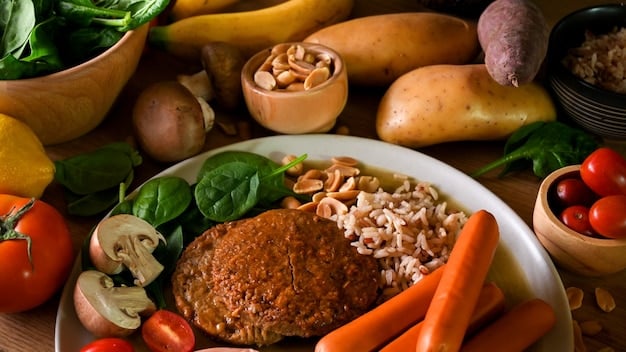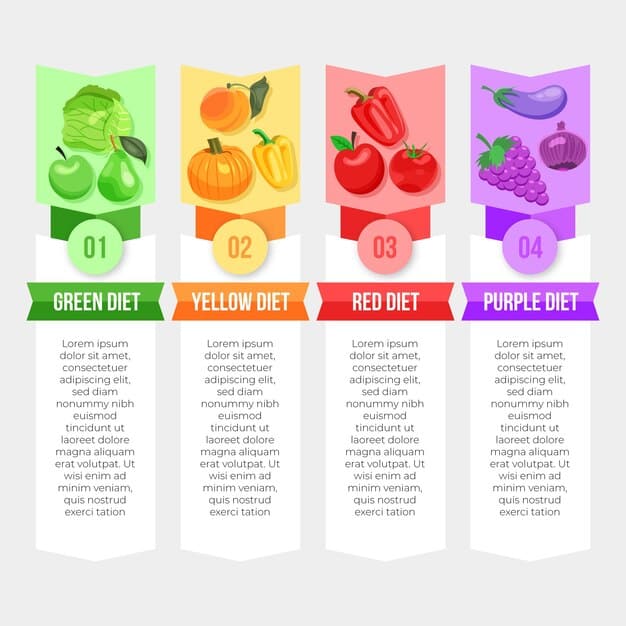Glycemic Index & Load: How They Affect Blood Sugar Control

The glycemic index (GI) and glycemic load (GL) are ranking systems for carbohydrate-containing foods that indicate how quickly they affect blood sugar levels, with GI focusing on carbohydrate quality and GL considering both quality and quantity for a more accurate impact assessment.
Understanding how does the glycemic index and glycemic load affect blood sugar control? is crucial for managing diabetes, weight, and overall health. This article breaks down these concepts, offering practical insights for incorporating them into your diet.
Understanding the Glycemic Index (GI)
The glycemic index (GI) is a ranking system for carbohydrate-containing foods. It indicates how quickly each food raises your blood sugar levels after you eat it. Understanding the GI can help you make informed food choices.
What Does GI Measure?
GI measures how rapidly a carbohydrate food raises blood glucose levels compared to a standard, usually pure glucose, which has a GI of 100. Foods are then categorized as having a high, medium, or low GI.
- High GI (70 or more): Foods that are quickly digested and cause a rapid rise in blood sugar.
- Medium GI (56-69): Foods that are moderately digested and cause a moderate rise in blood sugar.
- Low GI (55 or less): Foods that are slowly digested and cause a gradual rise in blood sugar.

Factors such as the type of carbohydrate, fiber content, cooking method, and ripeness can affect a food’s GI. For instance, white bread has a higher GI than whole-grain bread because it is more processed and has less fiber.
In summary, the glycemic index is a tool that measures how quickly foods containing carbohydrates raise blood sugar levels, categorizing them into high, medium, and low GI categories.
The Significance of Glycemic Load (GL)
While the glycemic index (GI) is a helpful tool, it doesn’t tell the whole story. Enter glycemic load (GL), which takes into account the amount of carbohydrate in a serving of food, providing a more complete picture of its impact on blood sugar.
How GL Differs from GI
GI focuses on the type of carbohydrate, while GL considers both the type and amount. This is important because eating a small amount of a high-GI food may not raise your blood sugar as much as eating a large amount of a medium-GI food.
- High GL (20 or more): Foods with a significant impact on blood sugar.
- Medium GL (11-19): Foods with a moderate impact on blood sugar.
- Low GL (10 or less): Foods with a minimal impact on blood sugar.
GL is calculated by multiplying the GI of a food by the amount of carbohydrate (in grams) per serving and then dividing by 100. This provides a more accurate assessment of the food’s impact on blood sugar levels.
In essence, glycemic load (GL) builds upon the glycemic index (GI) by factoring in the amount of carbohydrates in a serving of food, giving a better understanding of its overall impact on blood sugar levels.
GI and GL in Blood Sugar Management
For individuals managing diabetes or those simply aiming to maintain stable energy levels, understanding and utilizing both the GI and GL can be incredibly beneficial. They offer valuable insights for dietary planning.
Practical Applications for Diabetics
Diabetics can use GI and GL to make better food choices, helping them avoid drastic spikes in blood sugar. Choosing low-GI and low-GL foods can lead to more stable blood sugar levels throughout the day.
For instance, swapping out white rice for brown rice or choosing sweet potatoes over white potatoes can make a significant difference. These changes result in slower glucose absorption, preventing sharp spikes.
General Health Benefits
Even if you don’t have diabetes, focusing on low-GI and low-GL foods can help maintain stable energy levels, reduce cravings, and support weight management. This approach promotes sustained energy rather than quick bursts followed by crashes.

Therefore, integrating GI and GL into your dietary habits can effectively improve blood sugar management, ensuring greater energy stability and overall health benefits.
Foods with Low vs. High GI and GL
Knowing which foods fall into the low and high categories of GI and GL can significantly help in planning meals that support balanced blood sugar levels. Here’s a breakdown of common foods.
Examples of Low GI and GL Foods
Low-GI and low-GL foods are digested slowly, leading to a gradual rise in blood sugar. These foods often include high-fiber options and whole, unprocessed foods.
- Vegetables: Most non-starchy vegetables like broccoli, spinach, and peppers.
- Fruits: Apples, berries, and citrus fruits.
- Whole Grains: Oats, quinoa, and brown rice.
- Legumes: Lentils, chickpeas, and kidney beans.
Examples of High GI and GL Foods
High-GI and high-GL foods are digested quickly, resulting in a rapid increase in blood sugar. These often include processed and sugary foods.
- Refined Grains: White bread, white rice, and pastries.
- Sugary Drinks: Soda, juice, and sweetened beverages.
- Processed Snacks: Chips, cookies, and candy.
Therefore, a diet rich in low GI and GL foods promotes stable blood sugar levels, while one high in GI and GL foods can lead to frequent spikes and crashes.
Factors Affecting GI and GL Values
When evaluating GI and GL values, it’s important to understand that several factors can influence these measurements. Being aware of these elements can help you interpret the values more accurately and make better food choices.
Ripeness and Processing
The ripeness of fruits and vegetables can affect their GI. Riper fruits tend to have higher GI values because their starches have converted into sugars. Similarly, processing can also raise the GI of foods.
For instance, mashed potatoes have a higher GI than whole boiled potatoes because the processing breaks down the starch structure, making it easier to digest. Similarly, fruit juice has a higher GI than whole fruit due to the lack of fiber.
Cooking Methods
The way food is prepared can also alter its GI. Longer cooking times and methods that break down starches can increase the GI value.
For instance, pasta cooked al dente has a lower GI than pasta cooked until it’s very soft. This is because the starch in the al dente pasta is less accessible to digestive enzymes, leading to a slower rise in blood sugar.
Consequently, various factors such as ripeness, processing, and cooking methods can influence GI and GL values, highlighting the need for informed and adaptive dietary choices.
Incorporating GI and GL into Your Diet
Integrating GI and GL considerations into your daily diet doesn’t have to be overwhelming. Small, gradual changes can lead to significant improvements in blood sugar control and overall health.
Practical Tips for Meal Planning
Start by swapping high-GI foods for low-GI alternatives. For example, choose whole-grain bread over white bread and opt for sweet potatoes instead of regular potatoes. This small change can have a notable effect on your blood sugar levels.
Another helpful strategy is to pair high-GI foods with protein and healthy fats. This combination slows down digestion and the absorption of glucose, reducing the impact on blood sugar. For example, if you’re eating a slice of bread, add some avocado or nut butter to it.
Sample Meal Ideas
Consider incorporating more legumes, non-starchy vegetables, and whole grains into your meals. For breakfast, try oatmeal with berries and nuts; for lunch, enjoy a salad with grilled chicken or fish; and for dinner, have quinoa with roasted vegetables.
To summarize, incorporating GI and GL into your diet involves making informed food swaps, combining foods strategically, and focusing on meals rich in low-GI and low-GL ingredients.
| Key Concept | Brief Description |
|---|---|
| 📊 Glycemic Index | Ranks foods based on how they affect blood sugar levels. |
| 🍎 Glycemic Load | Considers both the GI and serving size for a more accurate blood sugar impact. |
| 🥗 Low GI/GL Foods | Vegetables, fruits, whole grains, and legumes. |
| 🥤 High GI/GL Foods | Refined grains, sugary drinks, and processed snacks. |
Frequently Asked Questions
▼
GI measures how quickly a food raises blood sugar, while GL considers both the speed and quantity. GL provides a more complete picture of a food’s impact.
▼
Choosing low GI and GL foods can help stabilize blood sugar and curb cravings, leading to better portion control and weight management.
▼
Most fruits are low in GI and GL, but some, like watermelon, have a high GI due to their sugar content. Consider portion sizes.
▼
Yes, cooking methods can alter GI and GL. For example, overcooking pasta can increase its GI, while al dente pasta has a lower GI.
▼
Familiarize yourself with the general GI and GL values of common foods. Regularly check when trying new foods or adjusting your diet.
Conclusion
Understanding how does the glycemic index and glycemic load affect blood sugar control? empowers you to make informed dietary choices. By focusing on low-GI and low-GL foods, you can stabilize energy levels, manage weight, and promote overall well-being for a healthier lifestyle.





